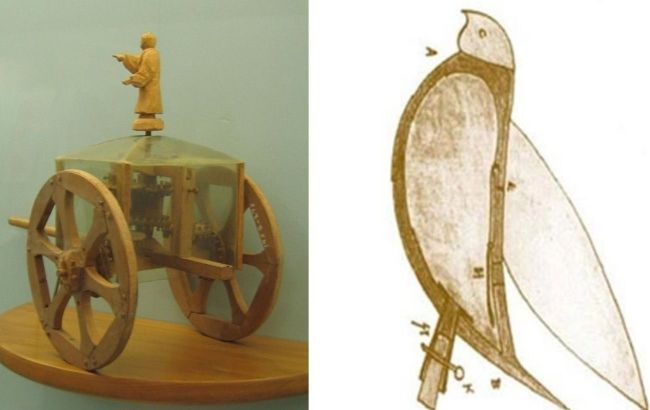Inventions of ancient world that were ahead of their time
 Top 5 ancient technologies that were significantly ahead of their time (collage: RBC-Ukraine)
Top 5 ancient technologies that were significantly ahead of their time (collage: RBC-Ukraine)
Sometimes, inventors come up with brilliant ideas that, despite their potential, face underappreciation from those around them. Some inventions can be so unusual that it's challenging to receive the recognition they deserve. It also happens that certain inventions are ahead of their time, making them underrated in the present.
RBK-Ukraine tells the story of ancient inventions that managed to surpass their time.
Sources used in preparing the material: Interesting Engineering, Big Think, Glarity.
Pigeon drone on a steam engine
In 428 BC, in Greece, an outstanding inventor, mathematician, and physicist of antiquity was born - Archytas of Tarentum. His research on the propagation of sound in the environment led to the creation of the first theory of acoustics in history. Archytas also developed schematics - a method of transmitting images of a working mechanism using geometric figures.
However, the most famous of his inventions was the wooden pigeon that could fly. This device was hollow, and had two large wings in the middle, and two smaller ones at the back, resembling tail stabilizers. The rear part of the pigeon had an opening connected to a leather bag placed in the body.
The process of using the device involved placing the bird on a boiling cauldron, after which steam was pumped inside until the pigeon took off. Chroniclers claimed that the apparatus could fly a distance equivalent to several hundred meters.

Pigeon drone on a steam engine (photo: Ancient Origins)
Automatic doors
In the 1st century AD, Heron of Alexandria, a mathematician and engineer, developed the first automatic doors in history.
The mechanism worked as follows: early in the morning, a priest would enter the temple through the personnel door and light a fire in the braziers. Under the influence of the temperature, water in copper pots would turn into steam, which, under pressure, moved through pneumatic pipes next to the door.
This steam filled counterweight vessels, activating a system of ropes and pulleys, gradually opening the doors. It took several hours from lighting the fire to achieve the desired result.
The doors that opened automatically in the temple provided believers with mystical feelings, creating the impression that higher powers were inviting them inside.
This remarkable mechanism was installed in a Roman temple near the city gates of Alexandria because it was believed that offerings to the gods should be presented in the best way possible to please them and prevent misfortune.
Heron described his automatically opening doors in his book Pneumatics, where he also mentioned his other inventions such as a steam boiler, a windmill, a muscle-powered water pump for firefighting, and many more.

Automatic Doors in Ancient Greece (photo: Artefacts Berlin)
Vending machine
Another device invented by Heron that was ahead of its time by several millennia. It was also installed in one of the Roman temples, resembling a kind of paid dispenser for holy water.
Temple visitors would toss a coin into a slot on the machine, and it would fall onto a tray inside. The tray, under the weight of the coin, would tilt, opening a valve and pouring a small amount of liquid into the container below. Then the coin would slide off the tilted tray, and the doors would return to their place.
This invention can be considered the first vending machine in history.

Vending machine (photo: Public Domain)
Seismoscope
Not only the ancient Greeks and Romans but also the ancient Chinese made their contribution to the creation of fantastic mechanisms that surpassed their time. Some of their inventions were practical, while others were simply intriguing concepts.
One such invention was the first seismoscope in history, presented by a scientist named Zhang Heng to the imperial court in the year 132 during the Han Dynasty era.
The device operated based on a sensitive pendulum hanging in a metal container. In the event of an earthquake, the pendulum would swing and hit the wall in the direction of the epicenter.
Simultaneously, a ball would drop from the mouth of one of the eight dragons attached to the seismoscope. It fell into the mouths of bronze toads positioned below, creating a loud sound, allowing observers to determine the direction of the disaster. This remarkable device was called the Dragon Emperor's Flutter and caused excitement at the court.
Despite its external simplicity, the machine turned out to be quite complex on the inside, with intricate levers and cranks ensuring the free movement of the pendulum in eight directions.
In the chronicle Book of the Later Han, there is a recorded instance when Zhang's device triggered, even though no one felt the earthquake. A few days later, a messenger arrived from the west, confirming that indeed an earthquake had occurred in the province of Luntai (now Gansu).

Seismoscope (photo: Britannica)
Chariot with navigation system
In our times, a car with a navigation system is nothing surprising. However, when 2,000 years ago, during the Three Kingdoms period, the Chinese inventor Ma Jun created a chariot with a built-in compass for Emperor Ming-di, it was a real wonder.
There was no magnetic compass in the inventor's creation, so he had to come up with an alternative. On the chariot's roof, he attached an arrow, which, through a complex system of gears, could always point in one direction.
At the beginning of the journey, when the cardinal directions were precisely known, it would be oriented to the south. Then the chariot would move, and every time it turned, the mechanism rotated the arrow to ensure it always pointed in the designated direction. It was purely mechanical with no magnetic compass - the Chinese began using those only in the 11th century.
To create such a device, Ma Jun had to invent a differential gear and a reduction mechanism. According to historical records, these navigational chariots were used until the year 1300 and were essential for long journeys and reconnaissance expeditions.
.jpg)
Chariot with navigation system (photo: Wikipedia)
We also have material about the 10 worst inventions in history.

